An Alchemy of Surfaces: The Shifting Exteriors of Japanese Cities
Back to Contents of Issue: February 2004
|
|
|
|
by Stephen Mansfield |
|
|
As cities, Japanese urban cores possess no visual equivalents of Roman foundations, Etruscan earthworks or Khmer tutelary stones. In cities where the longevity of buildings is measured not in epochs but in decades, we turn instead to the present for our architectural wonders.
Here are permanently unfinished cityscapes, driven as much by pragmatic as human needs, cities that are not, in the conventional sense, intended to be finished. Instead they are works in perpetual progress, their architecture a barometric measure of just how well they are doing. Deprived of the cozy illusion that anything could ever be permanent, the Japanese, assisted by a fairly weak preservation ethic, have voiced little objection to seeing their cities transformed into urban laboratories.
There is little compulsion to dwell on the past -- a condition ideal for aspiring architects eager to make their mark.
In this lightweight vision of the future, architectural heritage and the strong commitment to continuity which characterize European cities is excess baggage. "These extremely contemporary-looking structures," Donald Richie comments in his book, A Lateral View, "are like the tents of the nomads -- with the difference that the Japanese move not in space but in time." Built for reasons of economy, convenience and sometimes symbolism, these buildings, like the sets found in the back lots of corporate movie studios, are allowed to remain standing for as long as they serve a purpose. Then they are remorselessly torn down.
In the shift toward an information-based economy, buildings have become sounding boards and global-age transmitters. One can almost see on the surfaces of these buildings the shifting currents of the economy.
Japanese contractors, particularly the big five -- Kajima, Takenaka, Taisei, Obayashi and Shimizu -- have played a key role in transforming the appearance of these cities. The design and construction management within these companies work closely with their own cutting-edge research laboratories.
With a comfortable 45 percent market share in the industry, these institutions have tended toward safe, somewhat orthodox, monumental-scale designs augmented with high tech. In recent years, such companies and a growing number of smaller, independent firms have moved toward deliberate principles of indeterminacy and instability -- the deeply embedded characteristics of Japanese cities that have facilitated perpetual renewal and replacement.
Designer Botand Bognar has suggested that the economy-driven shift in design from "hardware" technology to electronic "software" technology -- resulting in the penetration of media and information technologies into urban settings -- has replaced intellectual engagement with an "appeal to human emotions and desires... an increased fascination with image and the sensual in architecture."
The merits of insubstantiality are highly visible in the work of Fumihiko Maki, whose constructions are routinely sheathed in floating membranes of aluminum screen, perforated panels and light reflecting surfaces. Shibuya's Cine Rise film complex, designed by Atsushi Kitagawara in 1986, is an early example of the attention to surface molding. The stagy appearance of the building, with its cast aluminum drapery, dissolving roof and webbing of wire-mesh blends well with the general cinematic pop quality of the area.
In William Gibson's sci-fi novel, Idoru, skyscrapers in the Shinjuku district are hatched from an organic building substance that seems, in the eyes of the story's main character, "to ripple, to crawl slightly... a movement like osmosis or the sequential contraction of some sea creature's palps." This may not be as far-fetched as it sounds. In Kuala Lumpur, where "bio-climatic" buildings use cooling systems to recycle heat and absorption chillers to regulate temperature and the flow of air into offices, architect Serina Hijjas believes that it will not be long before a "building skin is developed, one that would maintain itself and respond to climatic changes."
In a figure that corroborates the claim that in Japan renewal itself is a tradition, almost 40 percent of current Tokyo buildings were constructed since 1985. Where building values are only one-tenth the asset value of the land, it is hardly surprising that the urban building stock undergoes constant change. But the downside is cities with no memory, or at best, an accuracy-prone collective memory.
Despite their indiscreet wealth, Japanese cities are often cluttered urban masses that appear to evolve organically, layer upon squeezed layer. Like giant third-world cities, their exact perimeters are sometimes hard to define, the ribbon development of crowded suburbs melting into an anonymous sprawl.
The Patios 11 development in Chiba's Makuhari Messe bay area seems to be a deliberate effort to reverse this process. Limits have been set on the designs of street-facing facades, and building heights are carefully standardized. Although the apartment blocks appear be part of an American urban landscape, their colors -- terra-cotta, blue-gray and stained yellow ochre -- suggest the stucco dwellings of the Mediterranean.
When the complex opened six years ago, it still resembled an unvisited Expo housing site, occupied by a small contingent of brave but rather lost-looking families. The original advertising brochure for Patios depicted Caucasians jogging along pristine pavements, toddlers in designer clothes in sand pits and couples taking breakfast at a Continental-style street cafe. This seemed to portray a zone without a geographical identity or address, little more than a fashion town.
To some extent Patios has developed to fulfill this original impression: The spaces between its windy apartment blocks are now fleshed out with boutiques, French-style cafes, gardening showrooms and Italian restaurants.
Those who find the crowded but convivial hum and thrum of Japan's more typical urban areas liberating may find the severe order and polished exteriors of the Patios project stifling. Skeptics can take heart, though. Residents have already started hanging their futons out on sunny days, and flower pots and children's bicycles are breaking the surface order, poking through the contemporary fabric to add warmth and a human face to an architectural experiment. @
|
|
Note: The function "email this page" is currently not supported for this page.


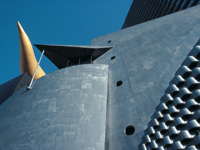 "The days when there was an immutable style are past... any work of architecture that, in a sense, internalizes the city and functions on its surfaces as a mechanism of transmission will symbolize today's image of the city."
"The days when there was an immutable style are past... any work of architecture that, in a sense, internalizes the city and functions on its surfaces as a mechanism of transmission will symbolize today's image of the city."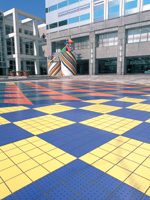 Before Nara and Kyoto became permanent seats of power, it was the custom to demolish entire capitals with the enthronement of a new emperor. Favoring the situational over the predetermined, Japanese architecture has always been linked to the fluctuations of the economy and the progress of technology, leading to intense periods of creative activity followed by the abrupt shelving in some cases of entire projects. The "bubble" years of the 80s were characterized by a shift from industrial expansion to a post-industrial, information oriented society with software elements dominating over hardware ones.
Before Nara and Kyoto became permanent seats of power, it was the custom to demolish entire capitals with the enthronement of a new emperor. Favoring the situational over the predetermined, Japanese architecture has always been linked to the fluctuations of the economy and the progress of technology, leading to intense periods of creative activity followed by the abrupt shelving in some cases of entire projects. The "bubble" years of the 80s were characterized by a shift from industrial expansion to a post-industrial, information oriented society with software elements dominating over hardware ones.
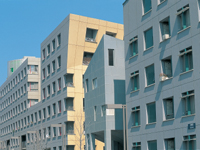 This is evident in the use of strong primary colors and pastels. Material such as glass tubing, gleaming metallic adjuncts, raw concrete, oxidized aluminum plates, translucent screens and fiber canopies are the order of the day, representing, perhaps, a new form of deconstructivism, or at least a disposition toward exterior surfaces that can be dismantled and replaced at will.
This is evident in the use of strong primary colors and pastels. Material such as glass tubing, gleaming metallic adjuncts, raw concrete, oxidized aluminum plates, translucent screens and fiber canopies are the order of the day, representing, perhaps, a new form of deconstructivism, or at least a disposition toward exterior surfaces that can be dismantled and replaced at will.
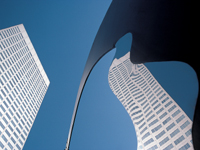 First impressions of Japanese cities, based on the perception that commercial gain generally outweighs the public interest, suggest just how much space is maximized. Rapid economic growth and a culture of assertive private land ownership manifests itself in the way buildings are rigorously marked off from each other. The slim gaps between structures, the slivers of air that characterize building rows in big cities here, may seem wasteful; they are far too narrow to use for anything much beyond storage space for pipes, vents and air-conditioner boxes. But they are carefully preserved as boundaries. The shafts of light and shade they create subtly alter the surfaces and seams of cities in ways not seen elsewhere. The structures known as "pencil buildings," the result of dividing land into slim parcels because of land prices or inheritance taxes, are a good example of structures so finely calibrated as to leave almost imperceptible divisions.
First impressions of Japanese cities, based on the perception that commercial gain generally outweighs the public interest, suggest just how much space is maximized. Rapid economic growth and a culture of assertive private land ownership manifests itself in the way buildings are rigorously marked off from each other. The slim gaps between structures, the slivers of air that characterize building rows in big cities here, may seem wasteful; they are far too narrow to use for anything much beyond storage space for pipes, vents and air-conditioner boxes. But they are carefully preserved as boundaries. The shafts of light and shade they create subtly alter the surfaces and seams of cities in ways not seen elsewhere. The structures known as "pencil buildings," the result of dividing land into slim parcels because of land prices or inheritance taxes, are a good example of structures so finely calibrated as to leave almost imperceptible divisions.
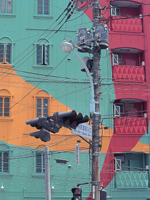 Close scrutiny of the block reveals other carefully deployed architectural effects, with some of the building surfaces tilted to distort space. In the case of one arresting maisonette in the south courtyard of the complex named the "House of Blue Shadow," walls have been covered with umber-colored brass panels. Other designations applied to the six individual courtyard houses and gatehouses integrated into the scheme of Patios 11, like the "House of Fallen Persimmon," "Color Reflecting House" and "House of Nothing," hint at poetic design abstractions to spur the imagination.
Close scrutiny of the block reveals other carefully deployed architectural effects, with some of the building surfaces tilted to distort space. In the case of one arresting maisonette in the south courtyard of the complex named the "House of Blue Shadow," walls have been covered with umber-colored brass panels. Other designations applied to the six individual courtyard houses and gatehouses integrated into the scheme of Patios 11, like the "House of Fallen Persimmon," "Color Reflecting House" and "House of Nothing," hint at poetic design abstractions to spur the imagination.



